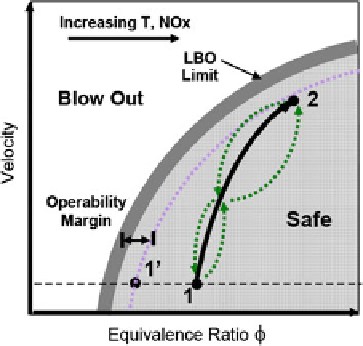Environmental Engineering Reference
In-Depth Information
Fig. 1 Detailed schematic of combustor operating regime and transients. The operating regime
(solid line) is designed such that the worst possible state (2) lies with safe margin from LBO limit.
As a result, the other operating states (such as 1) become non-optimal state produce more NO
x
(Chaudhari
2011
)
Thus, presently, the scheme of avoiding LBO by operating the combustor in rich
condition regime with a wide margin above the LBO limit tends to increase the NO
x
formation from engine. Enhanced performance can therefore be obtained with a
reduction in this margin. So, the ability to sense the proximity of combustor to
incipient LBO can provide signi
cant payoff in terms of operation economy and
reduce the overall emission.
1.1 Flame Dynamics Toward Lean Blowout
Before LBO, the
fl
flame shows some large-scale unsteadiness. Many studies char-
acterize this
fl
flame behavior toward LBO. Nicholson and Field (
1949
) reported that
the
flame undergoes large-scale pulsation as the combustor approaches blowout.
They also observed the repeated detachment and reattachment of
fl
fl
ame to the
fl
ame
holder before extinction. Hertzberg et al. (
1991
) reported similar pulsation of
ame.
Increased ignition time and local extinction of flame due to high instantaneous
strain rate are considered as the major causes of blowout. Chao et al. (
2000
)
observed the jet
fl
fl
flame for characterizing the blowout dynamics. They observed the
fl
flame blowout transience turning off the acoustic excitation. They postulate that the
blowout transient process can be divided into four regions: the pulsating, onset of
receding, receding and extinction. They found the
flame base pulsate in pulsating
region before the onset of liftoff and eventually blowout. Through LIPF and PIV,
they found that high strain rate encountered by the
fl
flame base which is more than
extinction strain rate is the primary cause of blowout process. Hedman et al. (
2002
),
fl

Search WWH ::

Custom Search